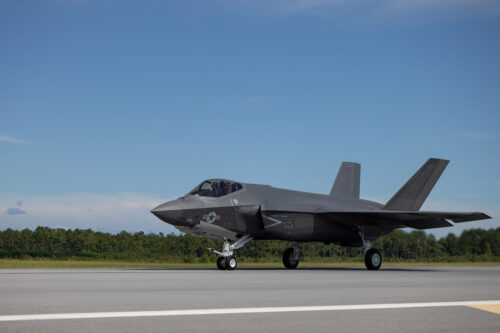In a pivotal moment for U.S. Marine Corps aviation, the skies over Marine Corps Air Station Cherry Point, North Carolina, witnessed a new era of aerial supremacy. On September 17, 2024, Marine Fighter Attack Squadron (VMFA) 251, better known as the “Thunderbolts,” received their first F-35C Lightning II jet, heralding a new chapter in the squadron’s storied history and marking a significant milestone in the Marine Corps’ ongoing modernization efforts.

A New Bolt of Lightning
The arrival of the F-35C at MCAS Cherry Point is more than just a delivery; it’s a transformation. VMFA-251 becomes the Marine Corps’ first East Coast operational F-35C Lightning II Joint Strike Fighter squadron, spearheading the 2nd Marine Aircraft Wing’s transition from legacy fixed-wing tactical aircraft to the cutting-edge F-35 platform.
Lt. Col. Evan Shockley, commanding officer of VMFA-251 and the pilot who flew the F-35C to its new home, emphasized the aircraft’s significance: “The F-35C Lightning II brings tremendous combat power to 2nd MAW, MAG-14, and MCAS Cherry Point. Its incredible range, firepower, sensors, and survivability, coupled with the fact that it is truly a Joint aircraft, makes it a lethal asset for Marine aviation.”
The Phoenix Rises
The “Thunderbolts” are no strangers to adaptation. After 34 years as an F/A-18 Hornet squadron and a final deployment supporting Operation Inherent Resolve, VMFA-251 deactivated in April 2020. Now, relocated to MCAS Cherry Point, the squadron is undergoing a renaissance, working towards reactivation and Safe for Flight certification with its new F-35C fighters.
This rebirth symbolizes the Marine Corps’ commitment to maintaining air superiority in an ever-evolving battlespace. The F-35C, designed for both carrier and land-based operations, brings unparalleled capabilities to the Marine Air-Ground Task Force (MAGTF).
A Force Multiplier
Col. Benjamin Grant, commanding officer of Marine Aircraft Group 14, highlighted the strategic advantage of the F-35C: “The one-two punch provided by the F-35C’s increased range and the F-35B’s STOVL capability will give MAG-14 and the MAGTF a significant advantage in the future fight.”
The F-35C’s superior internal fuel capacity translates to an extended combat radius and prolonged on-station times compared to its STOVL counterpart, the F-35B. This enhanced persistence is crucial for supporting Marines on the ground and maintaining air dominance in contested environments.
Looking to the Future
As VMFA-251 prepares to carry its legacy forward with the F-35C, the implications for Marine Corps aviation are profound. The integration of this fifth-generation fighter into the East Coast squadrons enhances the Corps’ ability to project power, deter adversaries, and support expeditionary operations across the globe.
For more information, hit the Source below